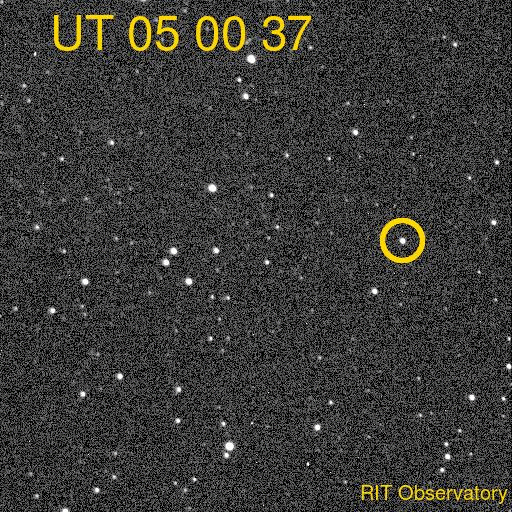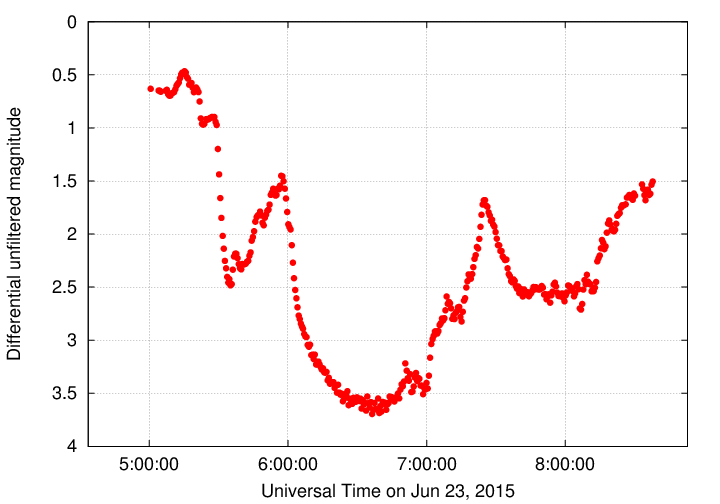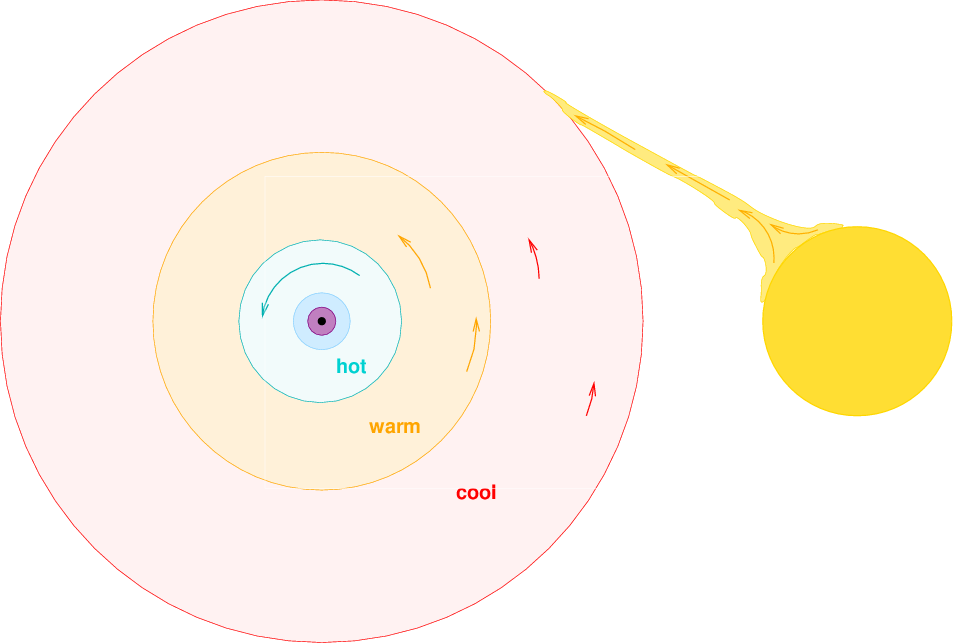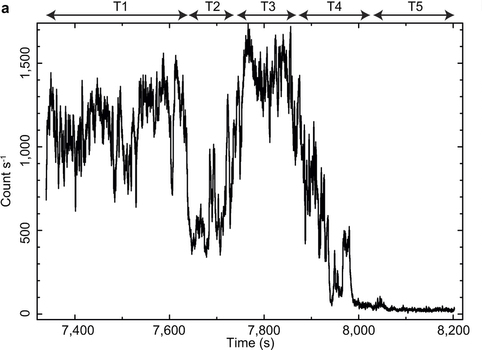

On the night of June 23/24, 2015, I observed the cataclysmic variable star V404 Cyg, using the 12-inch telescope at the RIT Observatory in Rochester, New York. Over a 3.5-hour period, the object dimmed to just 6 percent of its starting brightness, and then rose again to about half its original level. You can see the strong changes in its appearance in this animation (refresh the page to re-start the movie).


What's going on? Why is the brightness of this object changing so dramatically?
It turns out that V404 Cygni is a system consisting of an ordinary star and a black hole, orbiting around each other with a period of about 6.5 days. Most of the light we see is emitted by very hot gas, which has been torn off the ordinary star and is spiralling in toward the black hole.

Image credit Eiri Ono/Kyoto University
An international collaboration of astronomers led by Mariko Kimura at Kyoto University has just published a paper comparing optical observations of this system over two weeks to contemporaneous X-ray measurements. Let's look at what they found.
Astronomers have known for many years that V404 Cygn -- the name means "the 404th variable star found in the constellation of Cygnus, the Swan" -- is a binary system: two objects orbiting around each other. One object is an ordinary star, with a mass slightly smaller than our sun; the other has a much larger mass, roughly 10 times that of our Sun. Despite this very large mass, the second object does not (under ordinary circumstances) emit much light. That combination of very large mass, yet very small luminosity, is one clue that the second object may be a black hole.
The two objects are separated by a distance which is roughly 35 times larger than our own Sun's radius. They orbit around their common center of mass once every 6.5 days. Even though V404 Cyg B is slightly less massive than our Sun, its outer layers have expanded outward considerably due to its interaction with the black hole.
The strong gravity of the black hole pulls some gas away from the loosely-held outer layers of its companion. That gas settles into an accretion disk around the black hole. At first, as gas enters the outer layers, it orbits the black hole slowly. But as it spirals inward, the gas moves faster and faster, heating up as it picks up speed.

The cool outer layers emit infrared light, while the warmer layer emit visible light as well. The innermost layers are so hot -- temperatures over 1 million degrees! -- that they emit X-rays as well as ultraviolet, visible and infrared light.
Let's focus on these ultra-hot, innermost regions of the accretion disk.

Astronomers have known decades that the extremely hot gas at the inner edge of the accretion disk emits electromagnetic radiation of all types: X-rays, ultraviolet rays, visible light, infrared light, and even radio waves. However, since these hot inner regions are surrounded by the outer disk and a halo of cooler gas, most of that radiation is absorbed or scattered. Only the photons with the greatest penetrating power can fly through the obscuring gas and reach us directly.
Which photons are best at passing through material?

Image of hand courtesy of
Wikipedia
and
Hellerhoff
X-rays, of course!
So, in order to peer through the haze and see into the innermost regions of the disk, which are closest to the black hole itself, astronomers have long relied on X-ray satellites. We used the INTEGRAL and Swift orbiting telescopes to measure the X-rays emitted by the inner edge of the accretion disk.
The X-rays from V404 Cyg, like those from a few other black-hole systems, did not come out in a steady stream. Instead, we found short bursts and dips and several types of oscillations, on time scales of a few minutes to a few hours. Here's an example, showing about 3 hours of X-ray data.

These variations are caused by irregularities in the flow of hot gas through the inner rings of the accretion disk, just before it falls onto the black hole. Careful study of these variations can help us to understand the physical mechanisms governing the flow of gas through the disk.
As mentioned above, when we look at most black-hole binary systems with optical telescopes, we don't see similar quick changes in brightness. Although some optical light is emitted by this burbling, babbling, gurgling superhot gas, it is absorbed and scattered by the surrounding, cooler gas. The optical light we normally see comes from the outer regions of the disk, where the gas is much cooler, moving more slowly, and flowing more smoothly. The result: slow, gradual changes in brightness.
One of the big surprises in our study of this outburst of V404 Cygni was the discovery that the optical light from the system showed large, short-term variations in brightness which were similar to those of the X-rays.

Figure 3
from
Repetitive patterns in rapid optical variations in the nearby black-hole binary V404 Cygni
Nature 529, 54-58 (07 January 2016).
This is unexpected -- but a wonderful bonus! It suggests that in some (perhaps rare) circumstances, we may be able to peer deep into the accretion disk using visible light. That means we can use ordinary optical telescopes here on Earth's surface to study the regions close to black holes, instead of having to rely on the few X-ray satellites in orbit.
Now, the details are complicated. What's probably happening is that some of the X-rays from the innermost regions are flying outward and heating up gas in outer regions, which in turn emit large amounts of visible light. The variations in optical light are a somewhat indirect echo of the X-ray variations ( see a nice picture and explanation here), lagging behind by a minute or so. But as long as this echo is a faithful one, it allows use to use the optical light as a probe of the inner regions.
On top of that, V404 Cyg grew so bright during its outburst in the summer of 2015 that we were able to measure it precisely using small telescopes -- just 10 to 40 inches in diameter. These are well within the budget for an interested amateur astronomer or high school, which means that many amateur astronomers can contribute to similar studies of black hole systems.
Of course, a single telescope can only monitor a star while it passes through the night sky; it can't make any measurements during the day. In order to study V404 Cyg properly, a large collection of astronomers called the VSNET team combined their observations over several weeks. As soon as the star disappeared below the horizon of one site, another telescope started observing it. Working together, we collected over 85,000 optical measurements.
I'm just an observer, not a theorist, so I concentrate on making measurements; interpreting them is a job for my colleagues. But I'll try to state briefly here what our group has learned from analyzing the combined X-ray and optical dataset.
The oscillations in brightness of V404 Cyg are similar in some ways to oscillations in the X-ray output of a few other X-ray binary systems. However, the gas in those other systems is flowing into the black hole at much higher rates than in V404 Cyg. Models of the accretion process in those other systems suggested that instabilities and oscillations were a consequence of the enormous amount of gas surging through the disk each second.
The "current" of gas flowing through the accretion disk is much more gentle in V404 Cyg; in some cases, the flow rates were just a few percent of those in the other systems. Nonetheless, we saw similar oscillations in brightness, very likely due to similar instabilities in the flow.
What does this mean?
It might mean that some explanations for these instabilities need to be changed. Perhaps an important factor is the size of the disk, or its vertical extent. V404 Cyg and the few other systems which show these quick oscillations all have long orbital periods: the ordinary star and black hole orbit each other over the course of several days to several weeks; that means that the two bodies are separated by a large distance, many times the diameter of our own Sun.
There are many binary systems with black holes and ordinary stars with much smaller separations -- sometimes about the same size as our Sun, so that they complete one orbit in just 2 or 3 hours! Those short-period systems, however, seem not to exhibit the quick oscillations in X-ray or optical brightness that we see in V404 Cyg and its long-period brethren.
But remember -- I'm not an expert in these matters. I suggest you read the full paper (see the links below) to get the straight dope.